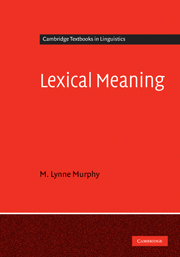Book contents
- Frontmatter
- Contents
- List of figures
- Preface: using this book
- Acknowledgments
- Typographical conventions
- Part I Meaning and the lexicon
- Part II Relations among words and senses
- Part III Word classes and semantic types
- 7 Ontological categories and word classes
- 8 Nouns and countability
- 9 Predication: verbs, events, and states
- 10 Verbs and time
- 11 Adjectives and properties
- References
- Index
10 - Verbs and time
from Part III - Word classes and semantic types
Published online by Cambridge University Press: 05 June 2012
- Frontmatter
- Contents
- List of figures
- Preface: using this book
- Acknowledgments
- Typographical conventions
- Part I Meaning and the lexicon
- Part II Relations among words and senses
- Part III Word classes and semantic types
- 7 Ontological categories and word classes
- 8 Nouns and countability
- 9 Predication: verbs, events, and states
- 10 Verbs and time
- 11 Adjectives and properties
- References
- Index
Summary
Key words:
aktionsart, aspect, static, dynamic, durative, punctual, telic, atelic, vendler class, activity, accomplishment, achievement
Overview
As we saw in chapter 7, typical verbs denote change – that is, the situations they describe are not time-stable. The last chapter concentrated on predication and the conflation of arguments into verb meanings, but it also discussed two types of situation that differ in their relationship to time: states and events. Stative verbs describe situations that involve little or no change, while dynamic verbs describe events in which changes, including physical actions or changes of state, happen. This chapter delves further into the relationship of verbs with time, exploring the differences between states and events and among various kinds of event. We are particularly interested here in lexical aspect, also known as Aktionsart.
- Type
- Chapter
- Information
- Lexical Meaning , pp. 201 - 221Publisher: Cambridge University PressPrint publication year: 2010

